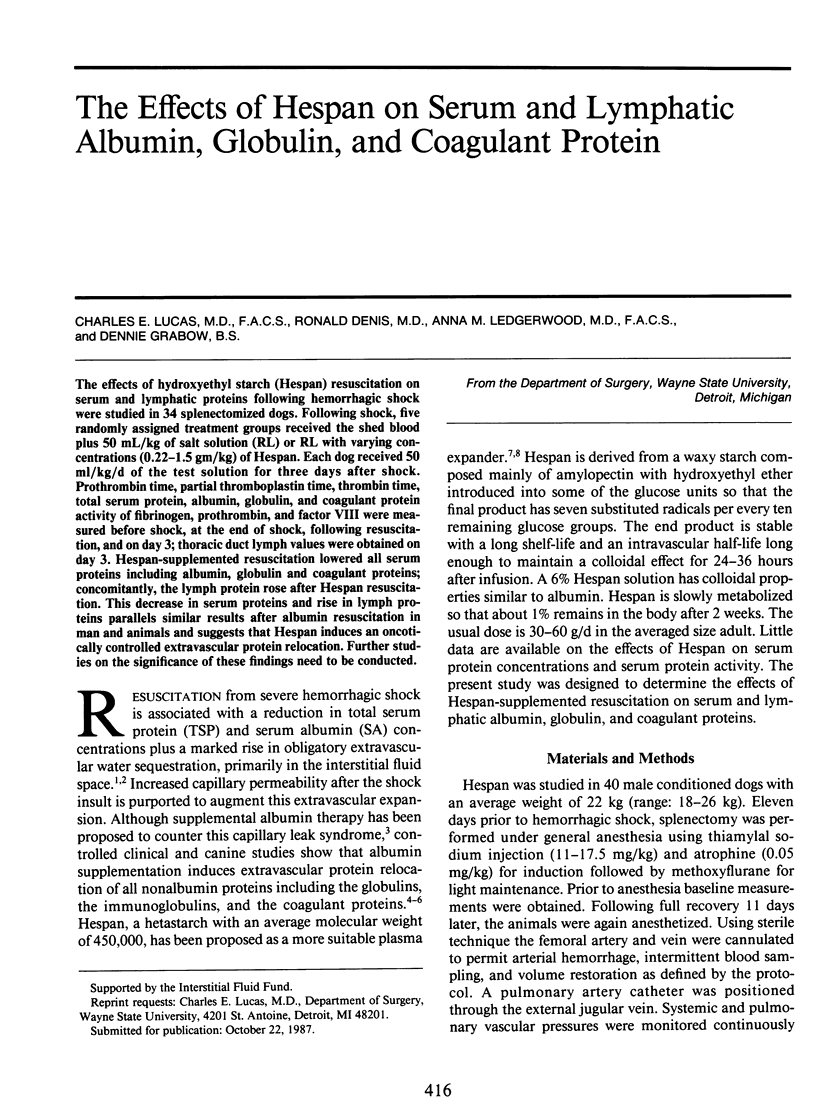Abstract
The effects of hydroxyethyl starch (Hespan) resuscitation on serum and lymphatic proteins following hemorrhagic shock were studied in 34 splenectomized dogs. Following shock, five randomly assigned treatment groups received the shed blood plus 50 mL/kg of salt solution (RL) or RL with varying concentrations (0.22-1.5 gm/kg) of Hespan. Each dog received 50 ml/kg/d of the test solution for three days after shock. Prothrombin time, partial thromboplastin time, thrombin time, total serum protein, albumin, globulin, and coagulant protein activity of fibrinogen, prothrombin, and factor VIII were measured before shock, at the end of shock, following resuscitation, and on day 3; thoracic duct lymph values were obtained on day 3. Hespan-supplemented resuscitation lowered all serum proteins including albumin, globulin and coagulant proteins; concomitantly, the lymph protein rose after Hespan resuscitation. This decrease in serum proteins and rise in lymph proteins parallels similar results after albumin resuscitation in man and animals and suggests that Hespan induces an oncotically controlled extravascular protein relocation. Further studies on the significance of these findings need to be conducted.
Full text
PDF




Selected References
These references are in PubMed. This may not be the complete list of references from this article.
- Denis R., Smith R. W., Grabow D., Ledgerwood A. M., Lucas C. E. Relocation of nonalbumin proteins after albumin resuscitation. J Surg Res. 1987 Nov;43(5):413–419. doi: 10.1016/0022-4804(87)90099-0. [DOI] [PubMed] [Google Scholar]
- Faillace D. F., Ledgerwood A. M., Lucas C. E., Kithier K., Higgins R. F. Immunoglobulin changes after varied resuscitation regimens. J Trauma. 1982 Jan;22(1):1–5. doi: 10.1097/00005373-198201000-00001. [DOI] [PubMed] [Google Scholar]
- Hauser C. J., Shoemaker W. C., Turpin I., Goldberg S. J. Oxygen transport responses to colloids and crystalloids in critically ill surgical patients. Surg Gynecol Obstet. 1980 Jun;150(6):811–816. [PubMed] [Google Scholar]
- Lazrove S., Waxman K., Shippy C., Shoemaker W. C. Hemodynamic, blood volume, and oxygen transport responses to albumin and hydroxyethyl starch infusions in critically ill postoperative patients. Crit Care Med. 1980 May;8(5):302–306. doi: 10.1097/00003246-198005000-00007. [DOI] [PubMed] [Google Scholar]
- Leibold W. C., Lucas C. E., Ledgerwood A. M., Mammen E. F., Denis R., Grabow D., Staricco R. J. Effect of albumin resuscitation on canine coagulation activity and content. Ann Surg. 1983 Nov;198(5):630–633. doi: 10.1097/00000658-198311000-00012. [DOI] [PMC free article] [PubMed] [Google Scholar]
- Lucas C. E., Benishek D. J., Ledgerwood A. M. Reduced oncotic pressure after shock: a proposed mechanism. Arch Surg. 1982 May;117(5):675–679. doi: 10.1001/archsurg.1982.01380290121021. [DOI] [PubMed] [Google Scholar]
- Lucas C. E., Bouwman D. L., Ledgerwood A. M., Higgins R. Differential serum protein changes following supplemental albumin resuscitation for hypovolemic shock. J Trauma. 1980 Jan;20(1):47–51. [PubMed] [Google Scholar]
- Lucas C. E., Ledgerwood A. M., Mammen E. F. Altered coagulation protein content after albumin resuscitation. Ann Surg. 1982 Aug;196(2):198–202. doi: 10.1097/00000658-198208000-00013. [DOI] [PMC free article] [PubMed] [Google Scholar]
- Okuno T., Selenko V. Plasma fibrinogen determination by automated thrombin time. Am J Med Technol. 1972 Jun;38(6):196–201. [PubMed] [Google Scholar]
- Penner J. A. Experience with a thrombin clotting time assay for measuring heparin activity. Am J Clin Pathol. 1974 May;61(5):645–653. doi: 10.1093/ajcp/61.5.645. [DOI] [PubMed] [Google Scholar]
- Shatney C. H., Deepika K., Militello P. R., Majerus T. C., Dawson R. B. Efficacy of hetastarch in the resuscitation of patients with multisystem trauma and shock. Arch Surg. 1983 Jul;118(7):804–809. doi: 10.1001/archsurg.1983.01390070016004. [DOI] [PubMed] [Google Scholar]
- Shires G. T., Cunningham J. N., Backer C. R., Reeder S. F., Illner H., Wagner I. Y., Maher J. Alterations in cellular membrane function during hemorrhagic shock in primates. Ann Surg. 1972 Sep;176(3):288–295. doi: 10.1097/00000658-197209000-00004. [DOI] [PMC free article] [PubMed] [Google Scholar]


